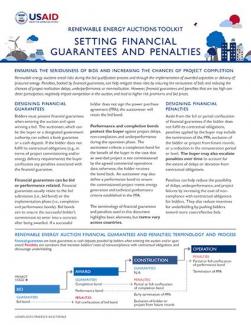Penalties, backed by financial guarantees, can help mitigate risks by ensuring the seriousness of bids and reducing the chance of project delays, non-completion, and underperformance during the operation phase.
Policymakers have many objectives for auctions such as promoting private sector investment and socioeconomic progress. Adapting the auction design to local framework conditions and priorities is one of the key steps to ensure success in achieving auction policy objectives. Good auction design can enable policymakers to advance many objectives, including reaching renewable energy targets, lowering generation costs, supporting the integration of renewable energy, and creating local jobs. Good auction design also mitigates risks to all parties and reduces the chance of project construction delays, non-completion, and underperformance during the operation phase.
Auctions involve risks during the bid qualification process and during the implementation of awarded capacities or delivery of procured energy. Penalties, backed by financial guarantees, can help mitigate these risks by ensuring the seriousness of bids and reducing the chance of project delays, underperformance, or non-completion. However, financial guarantees and penalties that are too high can deter participation, negatively impact competition in the auction, and lead to higher risk premiums and consequently bid prices.
Designing Financial Guarantees
Bidders need to present financial guarantees when entering the auction and upon winning a bid. The auctioneer, who can be the buyer or a designated government authority, can collect a bank guarantee or a cash deposit. If the bidder does not fulfill the obligations of the contract, e.g., in terms of project commissioning and/or energy delivery requirements, the buyer then confiscates any penalties associated with the financial guarantee.
Designing Financial Penalties
In addition to the full or partial confiscation of financial guarantees, penalties applied by the buyer may include the termination of the power purchase agreement (PPA), exclusion of the bidder or project from future rounds, or a reduction in the remuneration period or level. The buyer may also escalate penalties over time to account for the extent of delays or deviation from contractual obligations.
Determining the Size of Financial Guarantees and Penalties
Auction designers can set financial guarantees and penalties as a lump sum payment per unit of capacity or as a share of total investment costs. The size should be tailored to the context-specific project costs and risks and should consider the cost of obtaining material prequalifications already required from bidders.



